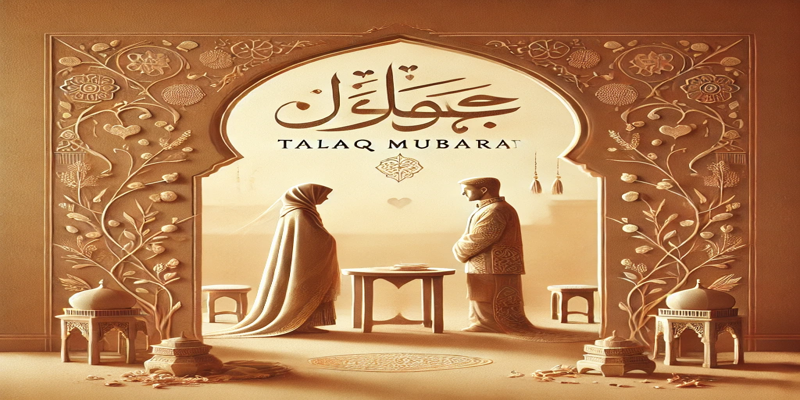Introduction
Talaq Mubarat is a form of divorce under Islamic law that involves mutual agreement between the husband and wife to part ways. In Islamic jurisprudence, divorce is not a simple or light matter; it is seen as a last resort when all efforts of reconciliation have failed. There are different types of divorce in Islam, among which Talaq (unilateral divorce initiated by the husband) and Khula (divorce initiated by the wife) are the most known. However, Mubarat stands out as a distinct form where both parties mutually agree to end the marriage without conflict. Understanding Talaq Mubarat provides insight into how Islamic law accommodates diverse situations in family life, ensuring that divorce happens with dignity and mutual respect.
This article delves into the concept of Talaq Mubarat, its significance in Islamic law, its process, the differences between Talaq and Khula, and the social implications of this form of divorce.
Meaning and Significance of Talaq Mubarat
Talaq Mubarat comes from the Arabic word “Mubara’ah,” which means “to free” or “to release.” In the context of marriage, Mubarat implies the mutual release of marital obligations by both the husband and the wife. While Talaq is initiated by the husband and Khula is initiated by the wife, Mubarat is based on mutual consent. Both spouses agree that they no longer wish to continue with the marriage, and they proceed with divorce in a peaceful manner.
Islamic scholars describe Talaq Mubarat as a situation where both the husband and wife experience an aversion toward continuing the marriage. It is not a one-sided decision but a joint effort to end the relationship. Mubarat represents an amicable solution, which is encouraged in Islam when it becomes evident that the marriage can no longer sustain itself. The Prophet Muhammad (PBUH) has highlighted the importance of reconciliation, but when it is not possible, Islamic law allows for divorce in a dignified manner.
Legal Basis and Scriptural Support
The Quran and Hadith provide a foundation for the different types of divorce, including Talaq Mubarat. Although the term “Mubarat” is not explicitly mentioned in the Quran, the principles governing mutual consent and resolution of marital conflicts align with the broader Quranic guidance on divorce. The Quran states in Surah Al-Baqarah:
“Divorce must be pronounced twice and then (a woman) must be retained in honor or released in kindness” (Quran 2:229).
This verse underscores the necessity of ending a marriage with kindness and respect. Talaq Mubarat is in line with this concept, as it is rooted in mutual agreement and aims to minimize bitterness and discord.
The Hadith also supports the idea of a mutually agreed-upon divorce. For example, a narration from the Prophet Muhammad (PBUH) highlights the importance of letting a marriage dissolve peacefully if both parties are unhappy:
“The most hated permissible thing in the sight of Allah is divorce.” (Abu Dawood).
While divorce is allowed, it is disliked, and the emphasis is on reaching a peaceful resolution if reconciliation is not possible. Mubarat, with its consensual nature, embodies this principle by allowing both the husband and wife to mutually decide that separation is the best course of action.
Talaq Mubarat vs. Talaq and Khula
Understanding the differences between Talaq Mubarat, Talaq, and Khula is essential for recognizing the unique nature of Mubarat within Islamic divorce laws.
- Talaq (Unilateral Divorce by the Husband): In a typical Talaq, the husband has the primary right to pronounce divorce. He can declare it unilaterally, and after completing the waiting period (iddah), the divorce is finalized. Although the husband holds the power in this case, he is required to follow certain procedures, including a waiting period and reconciliation efforts before the divorce becomes irrevocable.
- Khula (Divorce Initiated by the Wife): Khula is the form of divorce where the wife seeks a separation. However, for Khula to be granted, the wife must return the mahr (dower) or agree to certain financial settlements as compensation for the dissolution of the marriage. In Khula, the husband’s consent is necessary, but it is the wife who takes the initiative to end the marriage.
- Talaq Mubarat (Mutual Divorce): Mubarat is distinct because neither the husband nor the wife holds exclusive control over the divorce process. Instead, it is a mutual agreement. Both parties agree to dissolve the marriage, and usually, neither side demands financial compensation or the return of the mahr. However, if one spouse seeks compensation or requests the return of the mahr, this can be negotiated as part of the Mubarat process.
The critical difference between these forms lies in the nature of the divorce initiation. Talaq Mubarat is a cooperative and consensual process, unlike Talaq or Khula, where one party primarily drives the separation.
The Process of Talaq Mubarat
The process of Talaq Mubarat is relatively straightforward, given that it hinges on mutual consent. However, certain steps need to be followed to ensure that the divorce complies with Islamic principles:
- Mutual Agreement: The husband and wife must reach a mutual decision that they no longer wish to continue the marriage. This decision should be free from any coercion or pressure. The idea of Mubarat is based on mutual respect and understanding, so it is crucial that both parties are in agreement about ending the marriage.
- Documentation or Pronouncement: Once mutual agreement is reached, the divorce is either formally documented or pronounced verbally in front of witnesses, depending on the legal requirements of the country or region. In some jurisdictions, this may involve filing for divorce in a Sharia court, while in others, a simple agreement may suffice.
- Waiting Period (Iddah): Similar to other forms of divorce, Talaq Mubarat involves a waiting period (iddah) for the wife. The length of this period depends on whether the wife is pregnant or not. The waiting period serves as a safeguard to ensure that the wife is not pregnant, providing clarity on issues related to lineage and inheritance.
- Finalization of Divorce: After the waiting period, the divorce becomes final. Unlike Talaq, which can be revoked within the waiting period, Mubarat is considered an irrevocable divorce. Once the waiting period has passed, neither the husband nor the wife can withdraw their consent, and the marriage is formally terminated.
- Division of Assets: Mubarat may or may not involve financial settlements, depending on the agreement between the two parties. In many cases, neither party demands any compensation, and the couple mutually agrees to divide assets amicably. However, if one party seeks compensation, it must be mutually agreed upon.
The Social and Cultural Implications of Talaq Mubarat
Talaq Mubarat is an important aspect of Islamic law that offers a dignified solution for couples who no longer wish to remain in their marriage. By focusing on mutual consent, it ensures that both parties retain their dignity and self-respect throughout the divorce process. This aspect of Islam is significant in cultures where divorce can often be a source of social stigma or financial hardship.
Dignity and Respect
One of the primary social benefits of Talaq Mubarat is that it allows the couple to part ways with minimal conflict. In many cultures, divorce is often associated with acrimony and disputes over financial settlements or child custody. However, with Mubarat, the focus is on an amicable separation, preserving the dignity of both individuals. This mutual respect prevents the escalation of conflict and helps both parties move forward with their lives without lingering resentment.
Impact on Women’s Rights
Talaq Mubarat plays a crucial role in supporting women’s rights within the framework of Islamic law. Unlike unilateral divorce (Talaq), where the husband holds more power, Mubarat ensures that the wife has an equal say in the dissolution of the marriage. This equality is essential, particularly in conservative societies where women’s autonomy in marriage and divorce can sometimes be limited.
Moreover, since Mubarat is based on mutual agreement, the wife is not compelled to return her mahr, as she might be required to in Khula. This provision can be especially important for women who rely on the financial security provided by the mahr. The mutual nature of Mubarat allows for negotiation and compromise, ensuring that both parties’ interests are considered.
Challenges and Misunderstandings
Despite its benefits, Talaq Mubarat is not always fully understood or utilized in some Muslim communities. Cultural practices and traditional gender roles sometimes overshadow the principles of equality and mutual consent embedded in Mubarat. In some cases, societal pressure on women may make it difficult for them to negotiate on equal terms with their husbands. Additionally, the stigma associated with divorce in conservative societies can make it challenging for women to assert their rights.
To address these challenges, there is a need for increased awareness and education about Islamic divorce laws, particularly Mubarat. Islamic scholars and community leaders can play a vital role in educating couples about their rights and options within the framework of Islamic law. Moreover, ensuring that women have access to legal support and guidance can help mitigate any imbalances of power during the Mubarat process.
Conclusion
Talaq Mubarat is a valuable and significant form of divorce in Islamic law that highlights the importance of mutual consent and dignity in dissolving a marriage. It offers an alternative to the more commonly known forms of divorce—Talaq and Khula—by allowing both the husband and wife to reach a mutual decision to part ways. By focusing on peaceful resolution and mutual respect, Mubarat ensures that divorce occurs with the least possible harm to both parties.


